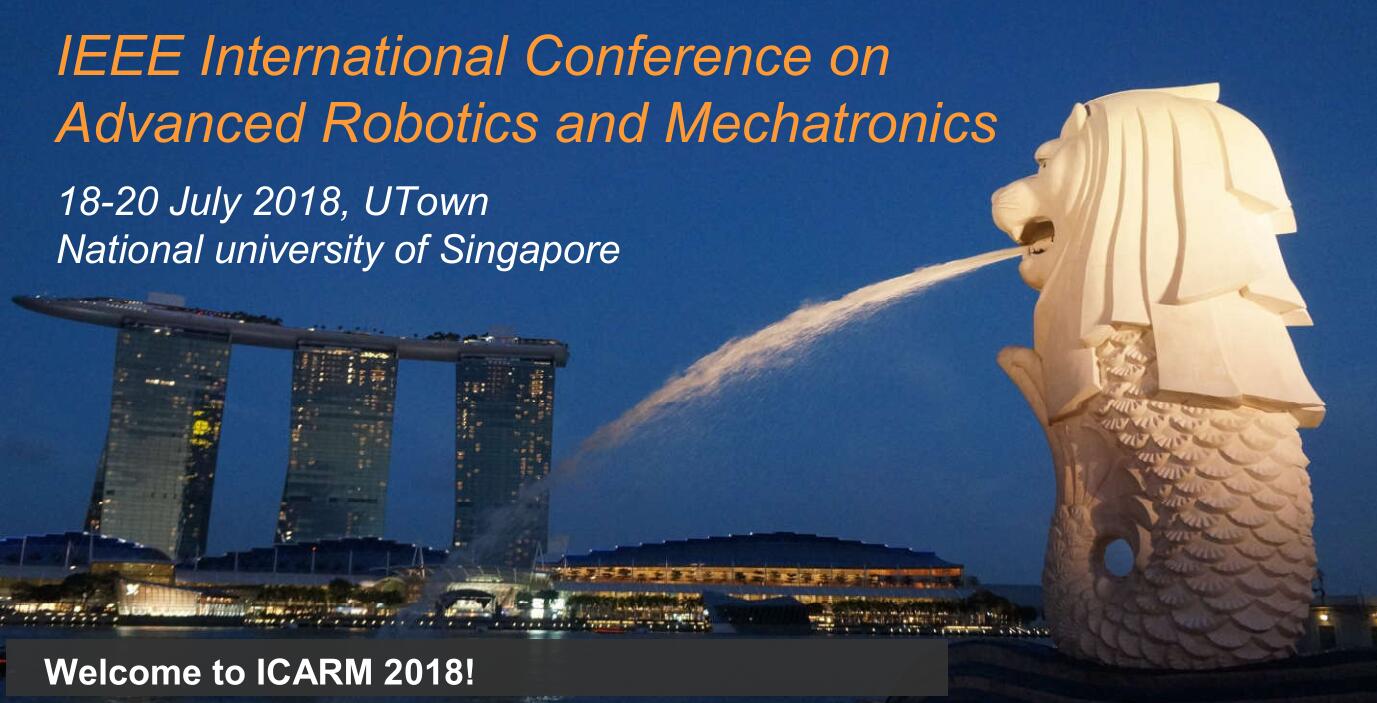INVITED SESSIONS
| Session Name | Chairs |
| Intelligent Control of Unmanned Systems | Liang Sun, Associate Professor School of Automation & Electrical Engineering, University of Science and Technology Beijing Email: liangsun@ustb.edu.cn Wei He, Professor Zhijia Zhao, Lecturer |
| The proposed session shows expertise in the area of control design of the unmanned systems to the audience of IEEE ARM’2018. This session particularly emphasize research work related to advanced intelligent autonomous control on unmanned robotic systems, unmanned aerial vehicles, and spacecraft. | |
| Human Robot Collaborative Intelligence: Theory and Applications | Chenguang Yang South China University of Technology Email: cyang@ieee.org Xiaofeng Liu Junpei Zhong Angelo Cangelosi |
| The submission for the session will be considered as a Special issue of “Human Robot Collaborative Intelligence: Theory and Applications” on Journal of Interaction Studies (IF:0.958). | |
| Perception and Knowledge Engineering | Hui Cao, Professor Xi’an Jiaotong University, China Email: huicao@mail.xjtu.edu.cn Xiali (Sharon) Hei Liao Wu |
| This session particularly emphasizes research work related to machine learning, data mining, knowledge representation, brain-inspired computing, and information analysis. | |
| Artificial Intelligence in Collaborative Robotics | Lei Cai, Associate Professor School of Information and Engineering,Henan Institute of Science and Technology Email: cailei2014@126.com Zhenxue Chen, Associate Professor Lan Wu, Professor Liangliang Chen, Research Fellow |
|
This special session is a good opportunity to contribute to this new exciting field. In particular, it emphasizes research work related to Artificial Intelligence algorithm for the engineering problem of collaborative robotics.
Potential topics include but are not limited to the following:
|
|
| Modeling, Learning and Control of Lower-Limb Exoskeleton Systems | Hong Cheng, Professor University of Electronic Science and Technology of China Email: hcheng@uestc.edu.cn Fuchun Sun, Professor |
| Lower exoskeleton Systems have gained considerable interests since its widely applications in military, rehabilitation and industrial scenarios. The fundamentals of lower exoskeleton can be characterized by: mechanical design, modeling, sensing, control, learning and interaction. The final goal of a lower exoskeleton is to finish particular tasks with different scenarios. | |
| Soft Robotics | Jian Zhu, Assistant professor Dept of Mechanical Engineering, National University of Singapore Email: mpezhuj@nus.edu.sg Dongong Zheng, Postdoc Fellow |
|
Soft robots attract interest from researchers due to their interesting attributes including compliant materials, large degrees of freedom, safety and adaptability. Soft Robotics Session provides a platform to exchange ideas on design and development of soft actuators, sensors and robots. This session invites submission from interdisciplinary areas, such as robot control, design, structure, material, and mechanics. | |
| Neuro-Robotics | Chi Zhu, Professor Maebashi Institute of Technology, Japan Email: zhu@maebashi-it.ac.jp |
| Neuro-robotics is one of the most exciting emerging technologies of the last decade to impact bioengineering, neuroscience, computer science and robotics. It is a combined discipline linking directly the nervous system with man-made devices. There are many subjects that are remained still open. For example, neural representation, modeling in motor systems, computing with neural spikes, hardware implementation of neural interfaces such as BMI/BCI. | |
| UAV Associated Vision | Zhi Gao, Research Scientist Temasek Laboratories, National University of Singapore Email: tslgz@nus.edu.sg Zhengxin Sun, Postdoc Fellow |
| Unmanned aerial vehicles (UAVs) have become a powerful and widely used tool for rescue, surveillance and exploration. To perform such tasks, UAVs have to fly autonomously in unknown environments, according to the obtained information for the purpose of flight control. In particular, the necessary tasks of motion estimation, localization or scene reconstruction, understanding are further complicated in GPS-denied scenarios. In recent years, UAV associated vision sensors and techniques have attracted wide attentions from multiple disciplines, and promising results have been reported. | |
| Closed-loop Grippers and Manipulators | Weiwei Wan, Associate Professor School of Engineering Science, Osaka University, Japan Email: wanweiwei07@gmail |
| Recent advancement in tactile and torque sensors, various levels of planning algorithms, and deep learning architectures are promoting the deployment of next-generation grippers and manipulators in manufacturing. Together with vision sensors, the grippers and manipulators already take places of several work done by human workers in unstructured environment. The examples include but not limited to separating postal packages, preparing mechanical components, cutting vegetables, assembly furniture, etc. This special session is organized under the background of the advances. It aims to collect papers discussing the most up-to-date studies in developing and deploying closed-loop grippers and manipulators in manufacturing. The organized session is expected to spark discussions on new techniques and new applications to completely replace human workers using closed-loop grippers and manipulators. | |
| Parallel Robots and Coordination Manipulation | Weiwei Shang, Associate Professor University of Science and Technology of China, China Email: wwshang@ustc.edu.cn Shengchao Zhen, Associate Professor |
| Parallel robots with physically closed-loop structure generally have potential advantages of high stiffness, speed, accuracy and large loading capacity. This session focuses on the research work of mechanism optimization, novel actuation, kinematic calibration, dynamic identification, dynamic control, motion planning and industrial applicationfor parallel robots. Furthermore, inspired by the closed-loop structure of parallel robots, this session discusses the coordination manipulation for dual-arm robots, multi-robots and multi-axis systems. | |
| Motion planning and control of human-robot system | Jian Huang, Professor, Huazhong University of Science and Technology, Email: huang_jan@hust.edu.cn Qin Zhang, Associate Professor |













